I am going to try and make this as simple as possible. For many, solar power is big black hole that they know they need to have but they don’t understand it. And because they don’t understand it, they either avoid doing something about it or buy something that doesn’t meet their needs. Our objective is to get the right thing the first time, like I described in a previous blog post – The Sweet Spot of Prepping
I am not going to get too detailed and confuse you but will write as if you were me several years ago when I knew little about portable solar systems.
There are several components of a portable solar system.
- Panels collect energy from the sun and convert it to electricity.
- Batteries store the energy that come from the panels. The batteries are typically 12 volts and store direct current (DC) electricity.
- The charge controller makes sure that the batteries don’t over charge and become damaged
- An inverter converts DC to alternating current (AC). Most home appliances are AC.
Some companies sell system in a functional, easy to use package. Examples are Humless, Goal Zero and Total Solar Technologies. You can also build your own system. Sometimes people might buy a Humless or Goal Zero system but buy panels somewhere else. For most it is easier to buy a package system.
Each system has its pluses and minuses. I am not going to get too detailed. One of the smartest guys on this subject I know is Grant Johnson. He guided me in was the best system/components for my needs. I purchased everything except my batteries from Grant. I already have heavy duty solar batteries from the solar system in my home.
What size system should I purchase?
One of the main questions is, “What size system should I purchase?”. That depends on what electrical appliances you want to use. My first system was a 60-watt system that I bought at Costco several years ago. I planned on using it to run lights for my tent and recharge batteries for headlamps and power tools. I was using a deep cycle marine battery. That system would work great for that application.
Then my wife and I visited a tent one of my clients had set up. They had a beefy solar system and had enough power to run whatever they wanted. They ran fans, a small fridge with a freezer, a microwave, and lights. When my wife saw this, she started thinking about appliances she would like to run when camping long-term. Fans were on top of her list. You can read about keeping cool at camp in this previous blog - Keeping Cool. Then she thought of a fridge, an ice maker, a wheat grinder, Bosch mixer, blender and electric tooth brushes. When she brought up a hair blower, that was over the line. Hair blowers eat up so much electricity because of the heating element. I want to have my wife be clean and comfortable when camping, but a hair blower is not happening. I think there are going to be a lot of women with short hair and ponytails after the grid goes down.
How many watts?
In determining the size system you need, you have to know how many watts you will be using. Each appliance will list the number of watts it uses. Add the watts from the appliances you want to have. Realize that you probably won’t be running everything at the same time. For example, we won’t be running the wheat grinder, the blender and the Bosch mixer at the same time. Most of the time none of these will be used and only one at a time when they are used. If the watts add up to 500, that gives you some guidance on the size system you should purchase.
Remember that the solar system generates DC. It is more efficient to use DC appliances. If you have AC appliances, the electricity has to go through an inverter which changes the current from DC to AC. This conversion typically has a 15% power loss. Because of this, my fans, fridge and lights are DC. The other appliances are AC.
Solar Panel Frames and Stands
One issue that isn’t talked about much, but is very important is frames and stands for solar panels. There are some advanced stands that will track the sun, adjusting during the day, thus generating maximum energy. Some companies have a tripod that hold their panels. On the other end of the scale, I have seen some people lean their panels on a bin as they rest on the ground.
When I considered the different stands, I didn’t see anything that met the criteria that I felt would be important in a long-term camping situation. My criteria were:
- Sturdy – protect the panels both in storage, transport and in use.
- Compact – take minimal space in storage and transport
- Lightweight – weight is a consideration in transport as well as daily use. I wanted the panels and frame to be able to be moved by one person.
- Perform in bad weather – I had two main considerations, snow and wind. I didn’t want the panels to be blown over by strong wind, and I didn’t want to have to have clean off the panels every time it snowed 3-6 inches.
Here is a picture of my panels and frames.
I have five, 100 watt panels, so I made one frame that holds three panels and the other that holds two panels. My panels are 47 X 21.3 X 1.4 inches and weigh 16.5 pounds. If you have an even number of panels, I suggest you use a two panel frame.
A couple of features you should notice. See how the panels are raised 12 inches off the ground. This allows snow to slide off the panels so that I don’t have to brush snow off after every storm. If there is a big storm, I will have to shovel show from the front of the panels so it doesn’t build up and block the panels from the sun. Also notice the gap between the panels. This allows air to pass through in the event of a strong wind. The panels can act like a sail in a stiff wind. By putting a gap between the panels, it allows the wind to more easily pass through and around the panels.
Here are some pictures with additional detail.
Front view

Side view - you can see how the frame folds up into itself, providing a narrow profile.

Back view
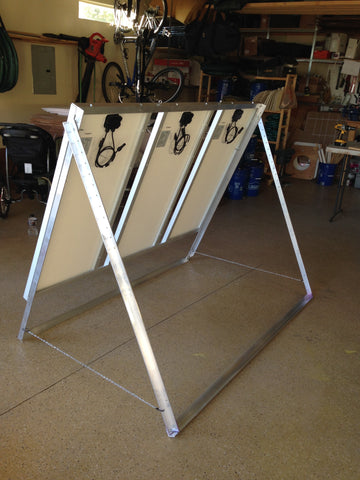
Adjusting holes

Pin
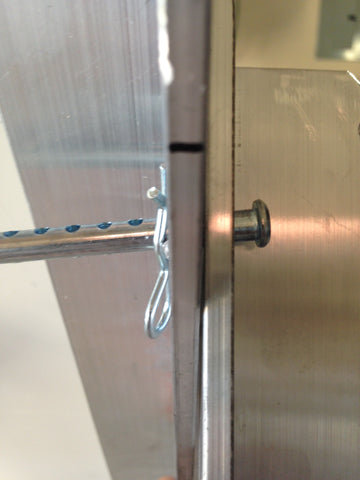
Chain support
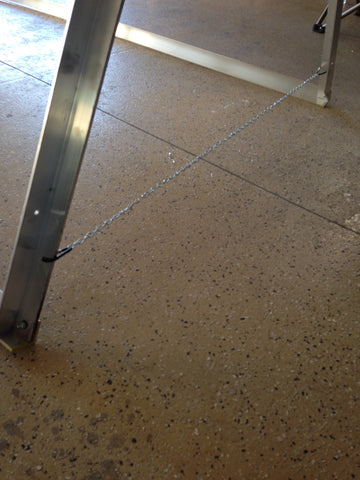
Chain storage - the chain cleanly attaches to the frame when not in use.
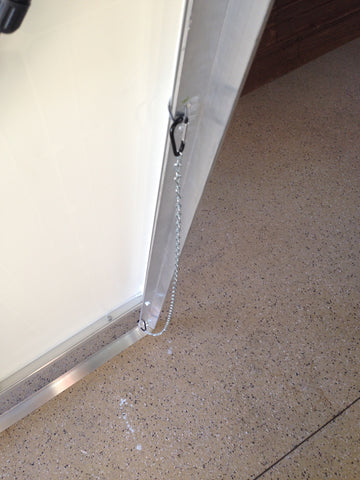
Eye bolt - there are two eye bolts on the top of the frame. In the event of a strong wind, one could string paracord through the eye bolt and tie it to stakes in front and back of the frame. This will secure the frame, eliminating being blown over and possibly damaged.
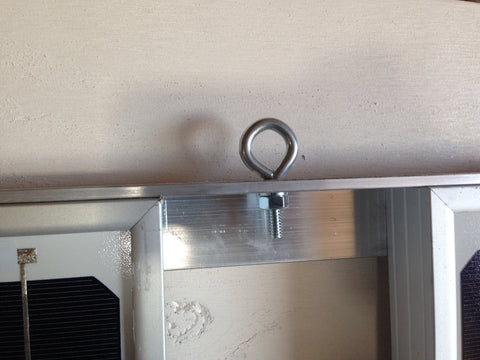
Is this something you would buy?
At a recent camp, a couple inspected my solar panel frames and asked if I would build a double frame for them. I am going to do that this week. I wonder if there are any other people that would like to purchase a kit with all the parts made along with assembly instructions. If you are interested in such a kit, let me know in the comments at the end of the blog. No commitment is necessary. I just want to know if there is enough interest to make it worthwhile. I don't know yet what the price would be.
A Big Boy Solar System
I have a friend that has installed his panels on top of his 26 x 8-foot trailer. He has six 235 watt panels and a 6,000-watt system. I tease him that he could be the neighborhood power company. His panels can pivot four ways - front, back, left right. They can also be removed from the trailer and placed on the ground with the ability to be adjusted and moved for the maximum charging position. He has cables from the panels to the solar system in the trailer. From the trailer, he runs electrical cords into his tent to power his appliances. He is hopeful, as am I, that we are allowed to park our trailers next to our tents when camping long-term.
Here are some pictures of the trailer, his panels and his dear wife sewing in the trailer. The trailer, with the ramp open in back and the side door open in front, was the coolest place in camp.
Panels in traveling position

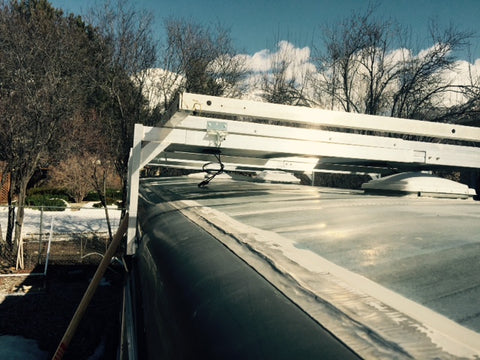
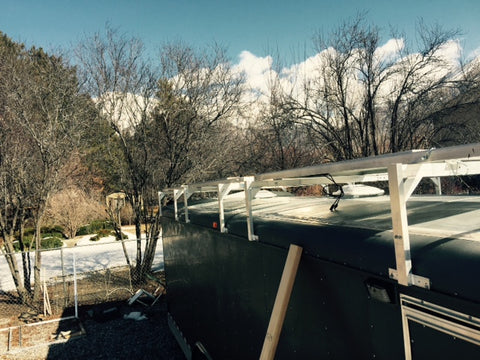

Cables entering roof of trailer through a water proof fitting
I share this example of what is possible. Not all have the same needs or resources. Whatever your electrical needs are, there is a solution for you. There is a lot of material on the internet regarding portable solar systems, in fact, so much that it is confusing. That is why I recommend that you determine the watts you want to use and then have someone you trust, like a Grant Johnson, to help you get the system that will provide for your needs.
And while considering your electrical needs, don’t forget these important low-tech solutions for keeping clean and efficient cooking; the Deluxe Tent Shower, Deluxe Camp Sink, Rocket Stoven Combo and Norwex Towels. USD
USD EUR
EUR


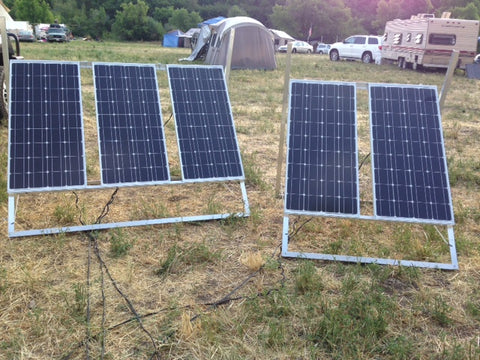
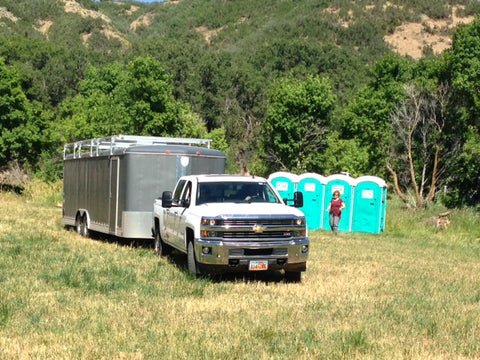
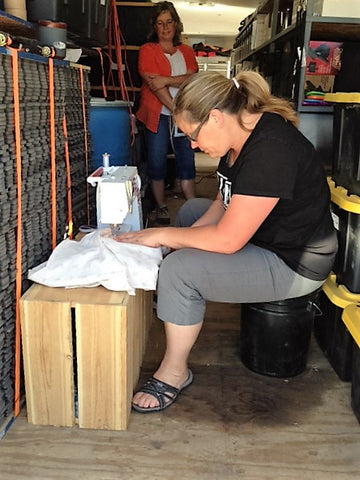
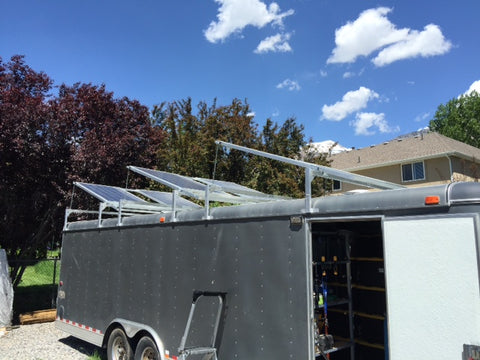
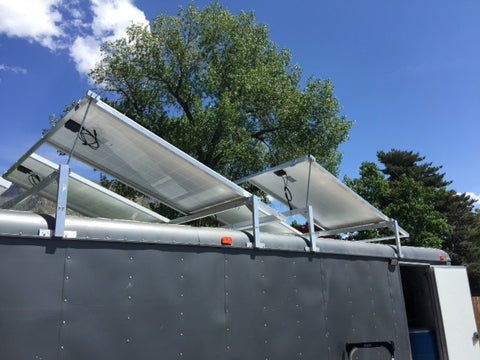
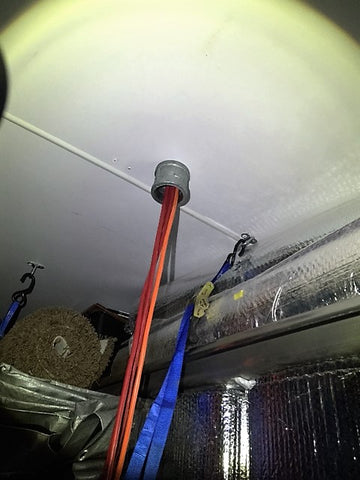
Jim Marshall says...
Your pics and instructions are the best I’ve seen so far, they are very easy to understand & interpret.
On August 24, 2018
Elise Dalton says...
I am very interested in frames for solar panels.
Thank you for your blogs. They are very helpful in considering what may be underdeveloped in our various preparations.
On October 05, 2016
Wayne Fletcher says...
Michael,
Suburb presentation! Need to visit with you on the solar.
Are you acquainted with David Willis? He is an engineer and does solar at pointzeroenergy.come His portable system is the best I’ve seen.
How do you get the roof mount on your trailer?
Wayne & Lynette Fletcher
Santaquin
PS: thanks for all of your help in getting us started.
On August 23, 2016
Cynthia Hunt says...
I am very interested in having you build frames for our solar panels.
On August 21, 2016